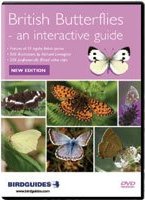 |
This DVD-ROM reference guide provides comprehensive multimedia coverage of all 61 butterfly species that regularly occur in Britain and Ireland (including the recently split Réal's Wood White). This new edition contains over 200 video clips presented using the latest high-quality digital video technology and filmed by professional natural history cameraman Derek Budd. 100 beautiful still photographs have been added, all maps updated with the latest distribution data and the text species accounts revised. You can easily compare any species side by side, with simultaneous video and wonderful illustrations by Richard Lewington. There are also evocative spoken commentaries for every species by naturalist Richard Williamson.
Plus, it's now possible to add your own content such as notes, photos or even video - all automatically integrated with the published assets for each species.
This DVD-ROM is produced in association with, and endorsed by, Butterfly Conservation. BirdGuides will donate £2 to Butterfly Conservation for every copy sold.
The DVD-ROM runs on Windows XP and Vista and Mac OS X 10.4 and 10.5.
I was delighted to be asked to review this product since, at first glance, it seemed to have much in common with the UK Butterflies website, and so I was intrigued to find out more. Was it simply a book in digital form? Did it simply contain content that could be found on the web - but neatly packaged up so that I could install it on my PC without having to worry about being connected to the Internet? Or was it something different altogether?
First things first. The product itself is very professionally-presented which gave me confidence from the outset that getting things up-and-running wasn't going to be an issue. And so it proved to be - within a couple of minutes I'd managed to install and register the software, with an application now looking back at me like an obedient dog, waiting for its first command.
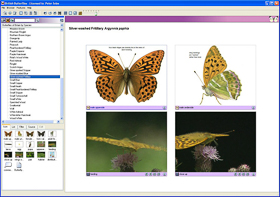 |
| One of the many layouts available |
Now, I have to say, I'm not one for reading instructions on how to get started with a software application. If it doesn't behave as I would expect, then I consider this a problem with the software and not with me. Some would call this arrogance on my part. I call it a test of the application's "usability". And on that note, I have to say I was up-and-running in seconds and so this product passes with flying colours on that front. Before I knew it, I was simultaneously hearing an audio description of the White-letter Hairstreak, watching a video of this species, looking at various photos and illustrations (by Richard Lewington, one of the greatest butterfly and moth artists who ever put colour to canvas), and scrolling through a species description. And some say that men can only do one thing at a time - shame on you.
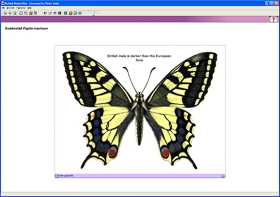 | 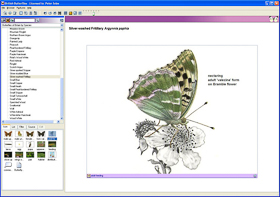 |
| Single species layout | Some subspecies, aberrations and forms (such as this valesina Silver-washed Fritillary) are included |
So let's discuss the content of this application. First off, it describes 61 species of British butterfly - although it's not immediately obvious why certain species have been selected and others not. All residents and regular migrants are here (including the Large Tortoiseshell and the reintroduced Large Blue) - and it's great to see that Réal's Wood White is a first-class citizen, our newest species on the British list. Intriguingly, although the application does not include rare migrants, such as the Camberwell Beauty, Pale Clouded Yellow or Long-tailed Blue, or extinctions such as the Black-veined White or Mazarine Blue, it does include the Large Copper. This, for me, would represent the only anomaly in the list, although it may be included on the basis of a "failed reintroduction". Aside from this species, my conclusion is that the application describes all species that one could expect most butterfly watchers to see in the British Isles in a year. As such - it's actually a pretty good list! Having said that, there is less content regarding forms and subspecies than I, personally, would have liked. Then again, I'm probably not your typical end user. And so, I think most users would be content with the level of content provided in this respect.
So what do you actually get for your money? Well, first off, you have readily available access to a heap of information. Yes, you could find some of this by perusing several books. Yes, you could find images of most species by trawling the Internet. Maybe, you could find video footage of the species concerned, but I doubt it. The list goes on. And that's one of the main objectives of this product - it pulls together a lot of information and presents it to you on a plate.
How much information? Well, most species show the male upperside, male underside, female upperside, female underside, a couple of commonly-encountered aberrations, the egg, the larva, the pupa, the habitat, and a couple of videos. In fact, that seems to be the minimum for each species. So that's 12 items per species across 61 species. That's getting on for 1000 items to peruse, before you even get started with the distribution maps, audio commentary and textual species descriptions.
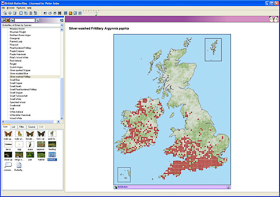 | 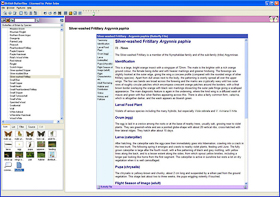 |
| Every species comes with an up-to-date distribution map | Species notes |
The user is able to peruse the information in many different ways - single images, various layouts and the very nice feature of being able to select any 2 items and compare them side by side - such as comparing Small and Essex Skippers.
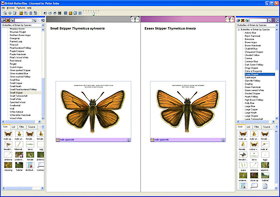 |
| Side-by-side comparison |
So - lots of information. However, there are a couple of things that niggle me. The first is that the coverage is somewhat inconsistent - although all species use Richard Lewington's illustrations to describe them, most have photos and videos of only the adult stage, where the immature stages would also benefit from, certainly, a photo or two, at least. Another gripe is that some photos of immature stages are against a backdrop of a jamjar, or some other receptacle - certainly not in their natural surroundings. All in all - my conclusion is that we live in an imperfect world, and creating the complete and perfect collection of illustrations, images, videos and the like, would take several lifetimes and the product would never see the light of day!.
Having said that - enter stage left for the "Piéce de résistance" in my opinion - the content is completely customisable. You can add your own images, video clips and notes - all managed by the underlying software. This may sound simple on the face of it - but when I think of how many people I've met that have an interest in Lepidoptera since digital photography exploded, I can't help thinking that this is just the product for them since it allows you to integrate your own images and observations within an overall framework provided by the application. Having played with the software for a few days, I've also learned that it's possible to add your own species too, although this does require some jiggery-pokery "under the covers" that is probably beyond the ability of many users.
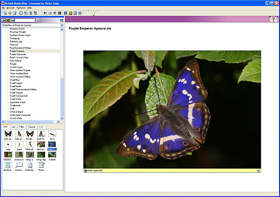 |
| One of my own images added to the Purple Emperor species listing |
And, of course, all software has bugs - that's just a fact of life. I've found a few minor errors in the content since I've been using it. For example, some of the captions on the Silver-studded Blue are incorrectly given. So I contacted BirdGuides and told them of some of the minor errors I'd found. The result - a "patch" to the product that was available within a week or so. I downloaded and installed the entire patch in under 60 seconds! What's more, it didn't zap any of my own images that had been added and now I've yet to find any errors in the content at all. But the responsiveness of the BirdGuides team left me with a very good feeling about this product and the support given.
The ultimate question is - would I have bought this software if I hadn't been sent a review copy? I've concluded that I'm not a typical user since I write software for a living. In the software industry, software developers suffer from the "not invented here" syndrome. That is, every software developer believes that, given a software product, they can write something better. But I can honestly say that I would struggle to build something as good as this. The flexibility, usability and video support (for several platforms) would take a very very long time to replicate, yet alone surpass.
In summary, I consider this to be a great product for those of us that what to maintain our own notes, photos, videos and the like - and have them all accessible in one place. So would I buy this product? The answer is a resounding "yes".
To order a copy, visit the BirdGuides website where you can also see more details about the product.
BirdGuides have provided a special offer for UK Butterflies visitors - buy "British Butterflies - an interactive guide" and get a free Garden Bird DVD! To take up this offer, please quote PKDRBFUK when ordering.